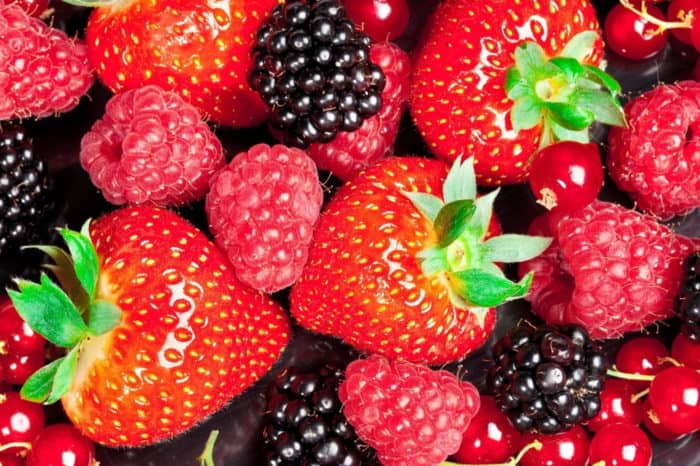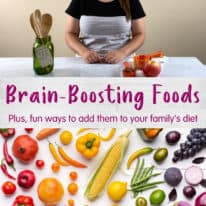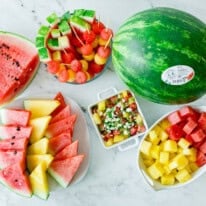Food Rx: Brain-Boosting Foods
Produce for Kids is teaming up with Julie Harrington, registered dietitian and culinary nutrition chef in a monthly series focusing on the important role food plays in overall health, plus sharing kid-friendly recipes to add more fresh produce to your family’s diet.

Looking for brain-boosting foods for your kids this school year? Here’s a list of 9 foods that are easy to incorporate into your family’s diet.
Back to school means a return to learning. Whether your kids will be learning at home or in the classroom this school year, proper nutrition is key to their ability to retain information and concentrate on their assignments.
This month’s Food Rx episode is going deep into brain-boosting foods! Watch the video below for great ideas to incorporate brain-boosting foods into your family’s diet. Have questions? Comment below on this post!
What role does food play in helping kids learn?
Mealtime is just as important as play time. A child’s diet plays a big role in helping kids learn at school. Certain foods contain nutrients that are necessary for brain development.
These foods can improve brain function, memory, and concentration. Like the body, the brain absorbs nutrients from the foods we eat and can help children boost their brainpower.
Supporting healthy habits and consistency, like a nutritious breakfast and lunches for school can help develop a routine, which can help develop lifelong healthy eating habits.
What are some brain boosting foods for kids?
We’re all aware of the importance of enough fruit and vegetables, but what else can we offer our children to optimize their chances of having a good day at school?
When incorporating new foods, start with lateral shifts. Take a meal or snack that they are familiar with and make small changes to incorporate more brain-boosting foods.

Eggs
Eggs are among the few foods that supply both choline and lutein, nutrients that are important for brain development, memory and life-long learning. New research is exploring how choline throughout life may have lasting effects on cognition and prevention of cognitive decline.
Ways to include more eggs:
- Make your own Egg McMuffin at home: just put a fried egg on top of a toasted English muffin, topped with a slice of cheese. Meal prep these ahead of time and put in the freezer for a quick and easy morning breakfast.
- Hard-boiled eggs are great as-is for a snack, but can also be added on top of a salad or turned into egg salad.
- Make mini egg frittatas using a muffin tin. Get creative with various mix-in combinations so you never get bored! Try combos like cheddar + broccoli, peppers + onions, spinach + feta, etc.
- Recipe idea: Veggie Breakfast Burritos with Turkey Sausage

Peanut Butter (or other nuts/seeds)
Kids tend to love peanut butter, and that’s a good thing since this healthy snack is packed with vitamin E, an antioxidant that protects nerve membranes. It also has thiamin, which is good for the brain, and glucose which gives energy.
*Is your school peanut-free? No problem. Replace with sunflower seed butter or soy butter in place of where you would normally use peanut butter. Try these other nut-free alternatives too.
Ways to include more nuts & seeds:
- Create a trail mix with nuts, seeds, dried fruit, whole grain cereal, and chocolate chips or try this Build Your Own Trail Mix Guide.
- Spread on apple slices or celery sticks.
- Add nut butter into smoothies.
- Top salad with nuts and seeds.
- Recipe inspiration: No-Bake Cranberry Pistachio Energy Bites

Whole Grains
The brain needs a constant supply of glucose and whole grains provide that. The fiber helps regulate the release of glucose into the body helping make energy last longer instead of peaking then crashing. Whole grains also have B-vitamins, which nourish a healthy nervous system.
Ways to include more whole grains:
- Transition to using whole grain chttps://healthyfamilyproject.com/a-guide-to-whole-grains/ereals, breads, crackers, etc. To ensure the item is whole grain, look for the first word on the ingredient list to say “whole”. You can also look for the whole grain stamp.
- Start small, even if it’s making a sandwich with one slice of white bread with one slice of whole wheat bread for sandwiches.
- Swap chips out with popcorn as a whole grain crunchy alternative.
- Baking? Add oats to pancakes, muffins, or waffle mixes.
- Recipe idea: Pear and Almond Overnight Oats

Salmon
Fatty fish like salmon are an excellent source of the omega-3 fatty acids DHA and EPA, both essential for brain growth and function. DHA is an omega-3 fatty acid that is required to keep the brain functioning normally and efficiently. Brain and nervous system tissues are partly made up of fat, and research suggests they have a special preference for DHA in particular.
Ways to include more salmon:
- Instead of tuna sandwiches, make salmon salad for sandwiches. Canned salmon mixed with reduced-fat mayo or non-fat plain yogurt, raisins, chopped celery, and carrots. Serve on whole-grain bread or whole-grain crackers
- Recipe idea: Baked Salmon Cakes

Berries
Think strawberries, cherries, blueberries, blackberries, and raspberries. Berries have high levels of antioxidants, especially vitamin C. Studies have shown improved memory with the extracts of blueberries and strawberries.
Ways to include more berries:
- Swap out jelly and make your own Strawberry Chia Jam.
- Blend into smoothies.
- Add berries to yogurt, hot or cold cereal, or dips. For a light dessert, top a mound of berries with nonfat whipped topping.
- Recipe idea: Blueberry Banana Pancakes

Apples
Apples are lunchbox-friendly and contain quercetin, an antioxidant that may fight decline in mental skills. Keep the skin on for extra fiber and nutrients. Learn how to keep apples from browning.
Ways to include more apples:
- Explore different varieties of apples. Gala, Honeycrisp, Jazz, Golden Delicious, etc.
- Utilize apples in savory (Ham, Apple Cheese Wraps) and sweet (Caramel Pear and Apple Nachos) applications.
- Recipe idea: Spiced Apple Quesadillas

Beans
Beans are an excellent brain food since they keep a child’s energy and thinking level at peak all afternoon if they enjoy them with lunch. Why? Because they have energy from protein, complex carbs, and fiber, plus lots of vitamins and minerals
Ways to include more beans:
- Top a salad with beans.
- Roast chickpeas for a snack.
- Add them to brownies (Trust us, you won’t even notice them!)
- Mash beans and spread onto a tortilla.
- Recipe idea: Beef & Black Bean Sliders

Colorful Vegetables
When we say eat the rainbow, we are thinking about colorful fruits and vegetables (sorry, Skittles). Tomatoes, sweet potatoes, spinach, zucchini, bell peppers, eggplant – the list can go on and on.
Vegetables with rich, deep color are the best sources of antioxidants that keep brain cells strong and healthy.
Ways to include more colorful vegetables:
- Make salads more exciting with various combinations and dressings.
- Dunk it! Cut up raw veggies, like carrots, cucumbers, peppers, etc. and dunk in hummus or dressing.
- If your child is grocery shopping with you, work together each time by picking a new vegetable from the colors of the rainbow.
- Add spinach into smoothies. (Tip: Making smoothies with colorful berries will hide the green color)
- Recipe idea: Grilled Chicken & Veggie Kabobs

Dairy
Dairy foods are packed with protein and B-vitamins, essential for the growth of brain tissue, neurotransmitters, and enzymes. Milk and yogurt also provide a bigger punch with both protein and carbohydrates, the preferred source of energy for the brain.
Ways to include more dairy products:
- Use milk, yogurt, or kefir as the base of smoothies.
- Cheese sticks are a great grab and go snack.
- Add milk to a bowl of whole grain cereal. (bonus – add berries on top!)
- Create yogurt parfaits layered with yogurt, nuts, and fruit.
- Recipe idea: Strawberry & Yogurt Bites

Other resources you may find helpful:
- The Best Lunchboxes for Kids
- Tips for Packing School Lunches
- Non-Sandwich Lunchbox Ideas
- Build a Better Sandwich
Disclaimer: Before making any health or diet changes, please consult your doctor. The information shared as part of Food Rx is meant to be informative but not replace medical advice from your doctor.














